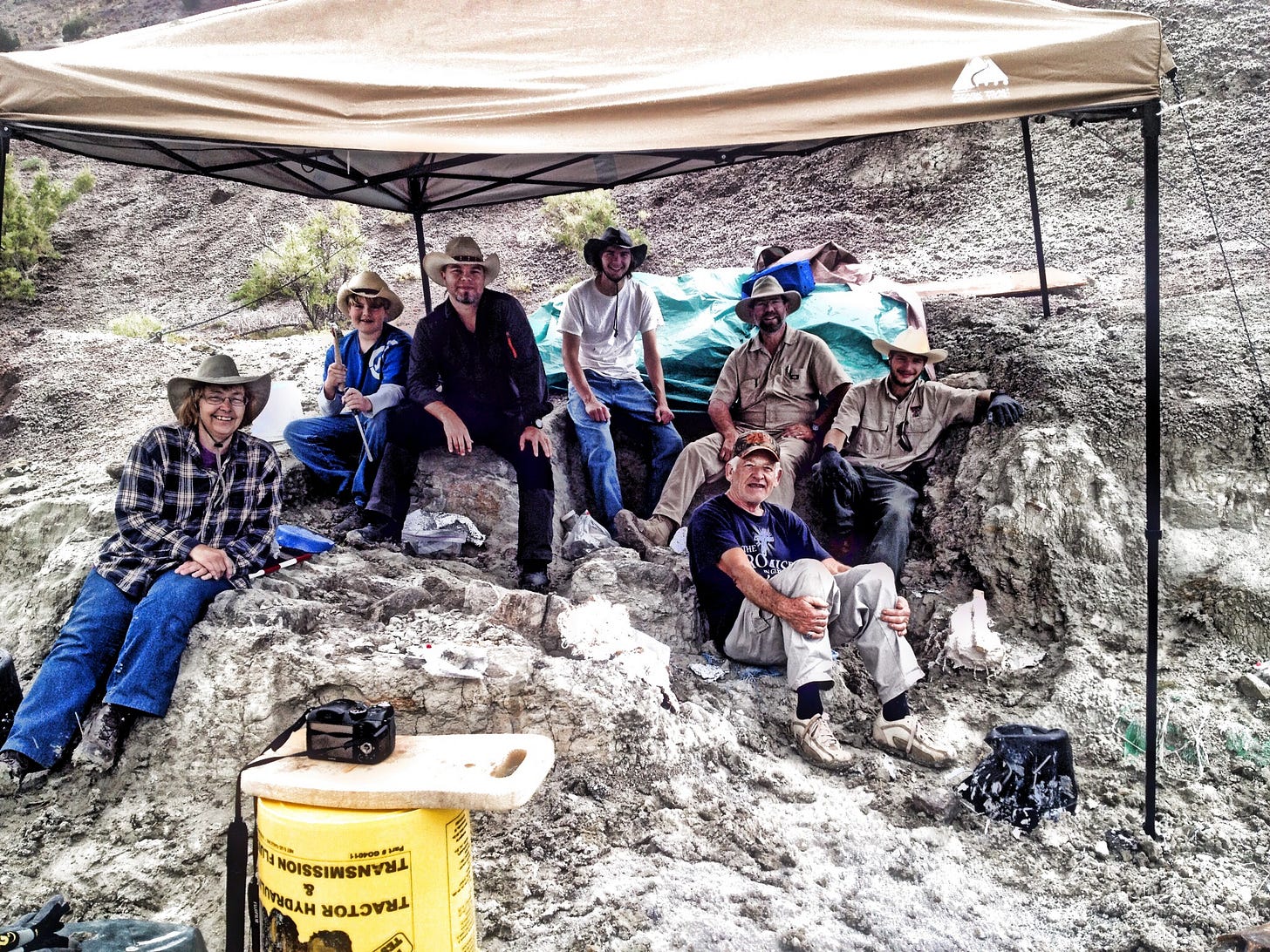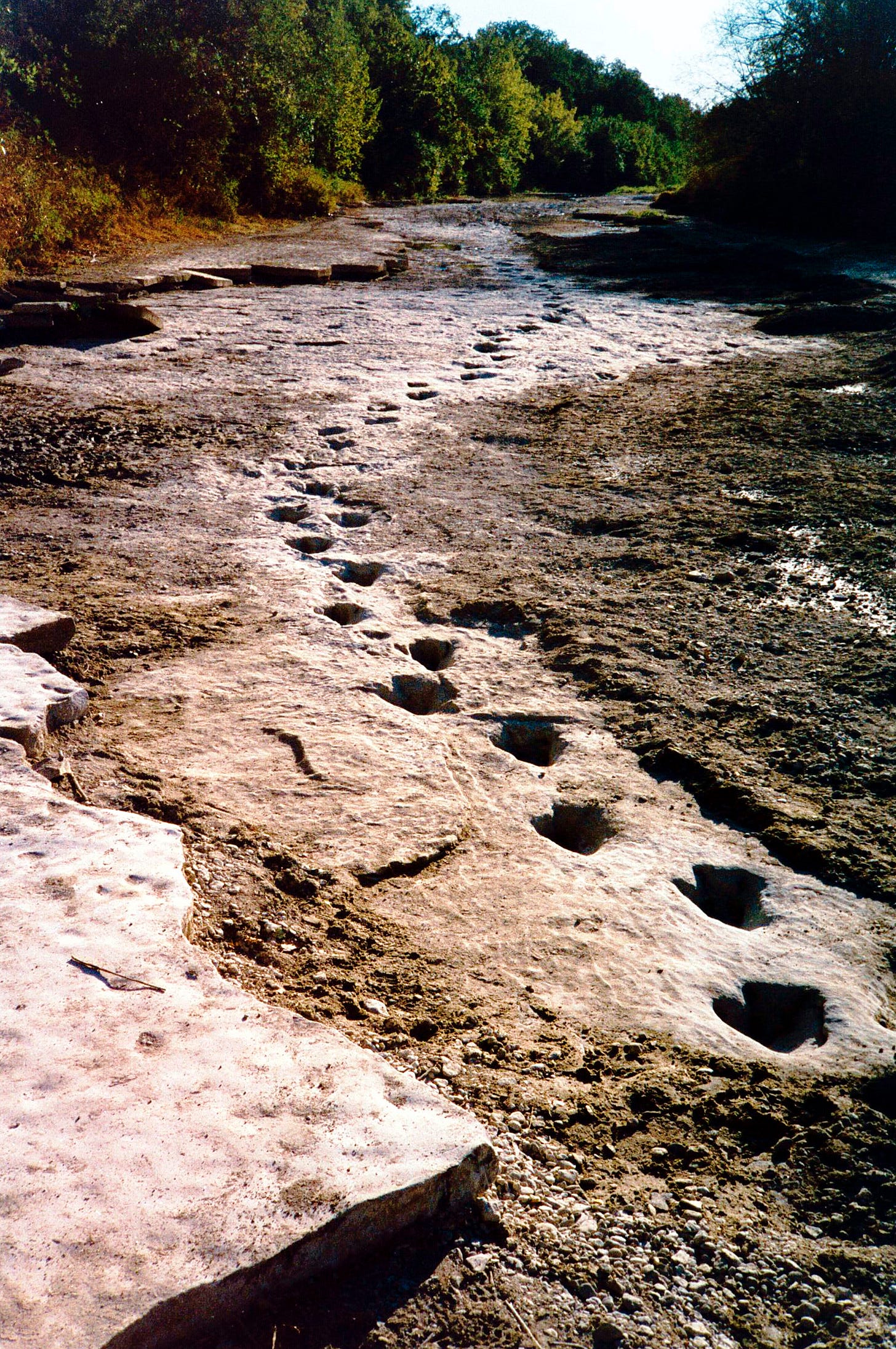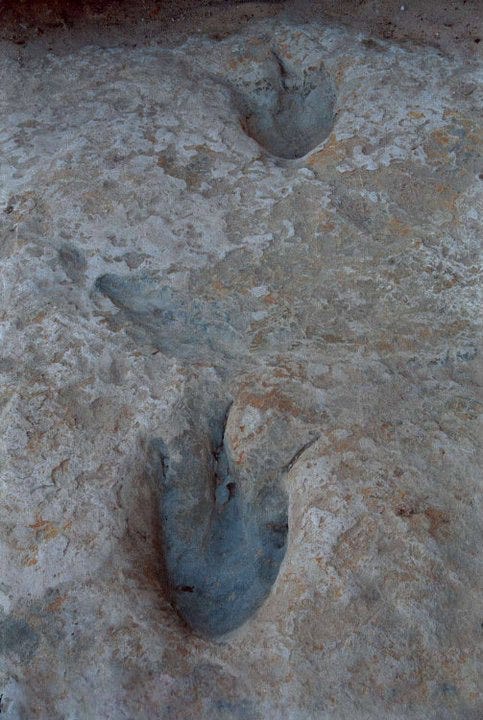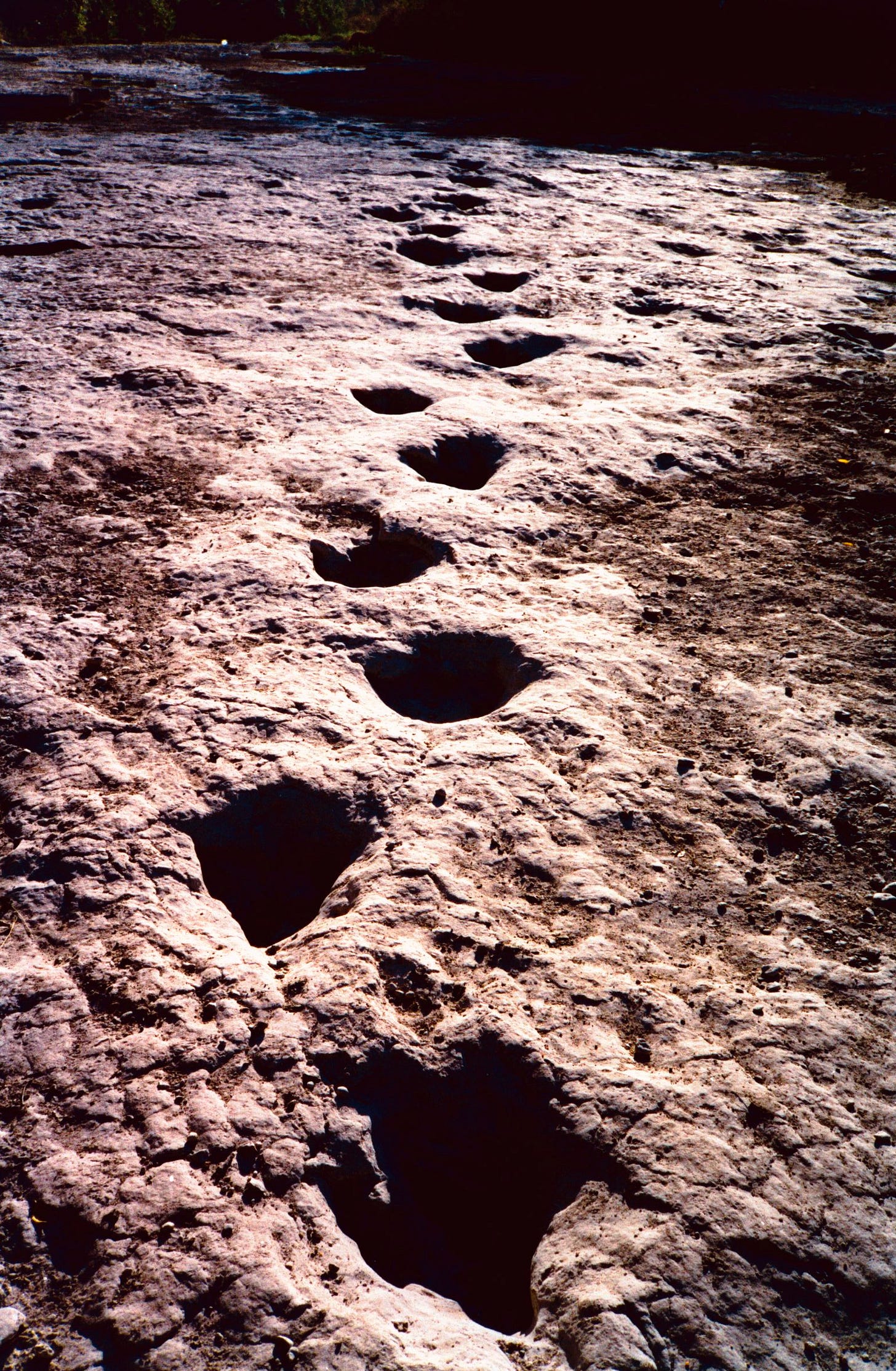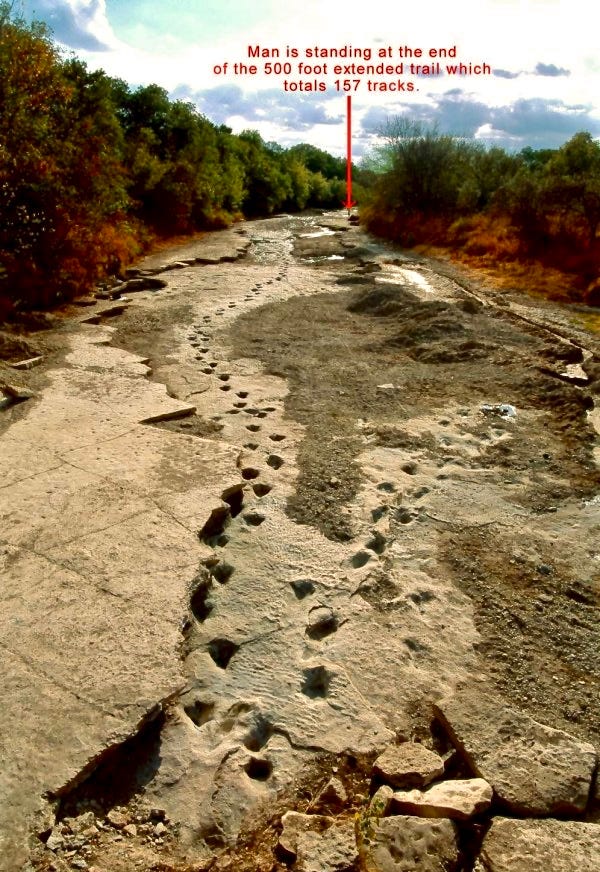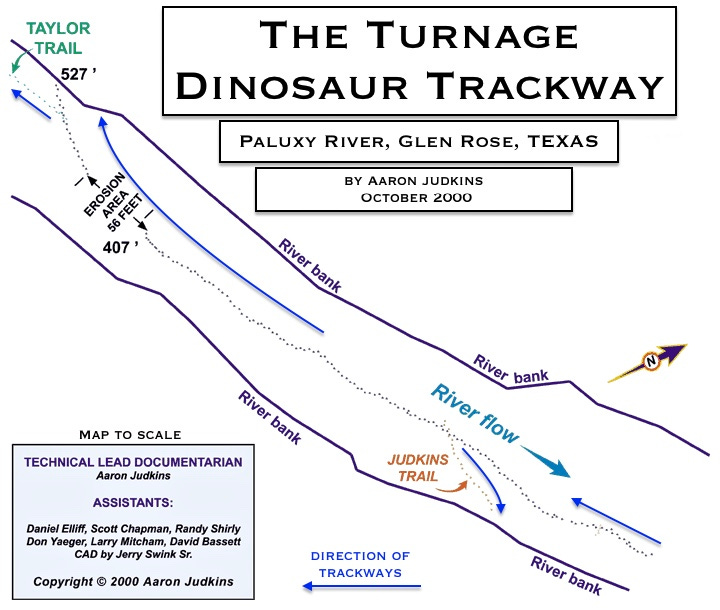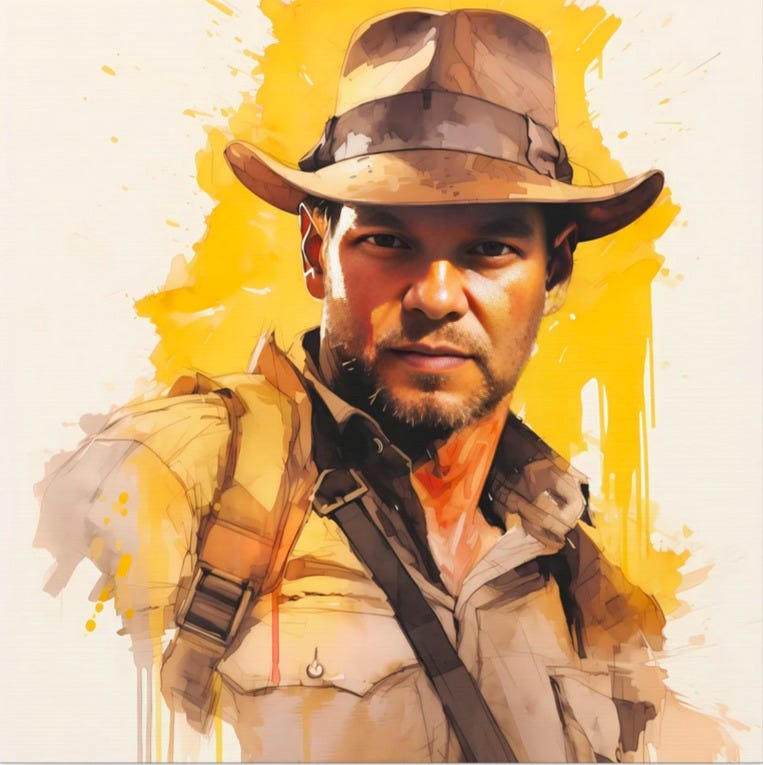The story of Glen Rose & its Dinosaur Legacy
Glen Rose, Texas, was a quiet community, originally admired for its pure artesian waters and cherished history of early settlers. Yet beneath its picturesque limestone riverbeds, a prehistoric secret awaited revelation. A dramatic event would soon shift Glen Rose from serene obscurity to paleontological prominence.
In 1908, the Paluxy River swelled ferociously, rising an unprecedented 27 feet in one of the worst flash floods on record. When the waters receded, something mysterious emerged beneath layers of washed-away sediment. Young George Adams, brother of local legend Earnest "Bull" Adams, was skipping school one morning following the flood's fury when he stumbled upon strange, three-toed impressions etched deeply into the limestone bed of Wheeler Branch creek.
At first, townsfolk dismissed these tracks, humorously attributing them to oversized turkeys. However, George felt compelled to seek answers, showing the curious tracks to his high school teacher, Robert E. McDonald. The astonished educator immediately recognized their significance: they belonged not to gigantic birds, but to massive theropod dinosaurs—fearsome carnivores of a bygone era.
Glen Rose’s reputation grew steadily as local intrigue deepened. In 1932, Charlie Moss uncovered even more spectacular tracks—large, rounded footprints unmistakably left behind by towering sauropods, then known popularly as “brontosaur” tracks. Yet, the town truly gained international fame only after the visit of famed paleontologist Roland T. Bird from the American Museum of Natural History in 1938. Bird's detailed studies brought Glen Rose worldwide attention when featured in a 1954 National Geographic article.
It was into this fascinating historical landscape that I stepped in 1996. Drawn to Glen Rose by my lifelong love of rocks and fossils—instilled in me by my grandparents—I was captivated upon my first visit to Dinosaur Valley State Park. Standing there in the ancient riverbed, seeing fossilized footprints preserved in solid stone, I felt transported through time. Closing my eyes, I imagined the scene: squish, squish, squish.
The heavy feet of an Acrocanthosaurus sank deeply into muddy coastal plains, leaving behind three-toed imprints. Her senses heightened, nostrils flaring, she paused momentarily, scanning for prey as pterodactyls soared overhead. Not far behind, enormous sauropods had passed, their gargantuan steps permanently pressing history into the limey mud beneath their massive weight. These fleeting moments of survival, now forever immortalized in the Paluxy limestone.
Inspired and determined, I delved deeply into Glen Rose’s prehistoric mysteries, volunteering with two museums- the Creation Evidence Museum and the Mt. Blanco Fossil Museum. I discovered new dinosaur tracks on the McFall property along the Paluxy and excavated dinosaurs from sites as far away as Colorado and Montana, driven by passion and an ever-growing sense of wonder.
Colorado Dinosaur Dig- 2016
Thank you for reading Dr. Aaron Judkins Substack. To continue reading this article, consider upgrading your subscription. Unlock full access to this and other in-depth content exploring mysteries, legends, and the truth behind them. Your subscription supports our work and allows me to bring you more articles like this.
In the scorching summer of 2000, nature presented a rare opportunity: an extended drought of 84 rainless days (from July 1 to September 23, 2000) left the Paluxy River reduced to shallow stagnant pools, unveiling its hidden secrets. Remembering earlier accounts from 1971, when local resident Mike Turnage first documented footprints submerged beneath chest-high water, eventually tracing 100 dinosaur tracks with his feet.
Fellow researchers and I assembled on September 9, 2000 to finally bring this hidden trail fully into the light. We pumped stagnant water from the site, painstakingly clearing away thick layers of silt, debris, and sediment. On October 2-6, 2000, the Creation Evidence team was brought in to excavate and extend the trail. Over three exhausting weeks, we gradually unveiled the remarkable “Turnage Trail,” (now known at the Lone Ranger Trail) honoring Mike Turnage’s pioneering discovery nearly three decades earlier. As the trail was uncovered, it extended beyond the original 100 tracks that Mike Turnage had counted to a present 157 dinosaur tracks! The trail was laid out in a long, consecutive pattern right up the middle of the riverbed. What a glorious sight! When finally uncovered, we stood in awe: stretching a breathtaking 527 feet, the trail featured 157 clearly preserved dinosaur footprints. This was the first time human eyes had ever seen the trail exposed in its entirety. Each averaged 15 inches in length and 6 inches deep, with a nearly continuous sequence interrupted only briefly by erosion.
The Turnage Trail- October 2000
After meticulous documentation, careful mapping, and over 200 hours of rigorous scientific labor concluding on October 14, 2000, I contacted renowned ichnologist Dr. Martin Lockley. On November 6, 2000, Dr. Lockley confirmed that this trackway represented the longest single continuous dinosaur trail discovered anywhere in North America. Our hearts soared with pride and amazement. Nearby, intersecting the Turnage Trail, another striking trackway—later named the "Judkins Trail" after my own careful work mapping it—revealed 21 unique, pigeon-toed tracks with vivid claw impressions still distinctly visible.
The Judkins Trail
The summer sun dipped low behind Glen Rose’s cedar-covered hills, painting the valley in amber and gold. Standing there, surrounded by ancient footprints, I felt humbled by the profound continuity of life. Each footprint served as a powerful reminder: long after we are gone, evidence of our existence—our own footprints—may remain, etched within Earth's eternal trail.
Since then, nature has occasionally offered additional glimpses into this prehistoric pathway. Each new opportunity deepens our understanding of these magnificent creatures that walked along this area. Extreme drought conditions in 2011 and again in 2022 provided further chances to revisit, study, and perhaps extend the Lone Ranger Trail. 2022 proved to be the second hottest July on record and the sixth longest stretch of triple-digit days at 21. It was the second driest July on record and the second longest stretch of consecutive days without rainfall at 58 through the end of July this year.
Today, Glen Rose remains a beacon, not merely of early Texas history, but also of humanity’s enduring fascination with the distant past. Like the footprints themselves, our efforts echo through time, reminding future generations of our shared legacy—the incredible footprints left behind by dinosaurs, and the humble steps we ourselves take upon life's eternal path.
The Turnage Trackway, October 2000
Paluxy River, Glen Rose TX
As a token of our appreciation, we're offering you a limited-time offer of 20% off a paid subscription for your first year.
Here are the benefits you unlock with a paid subscription:
Subscriber-only posts and full archive
Post comments and join the community
Thanks again for reading.
PS. If you loved this article, be sure to head over to our Ancient Pathways Patreon site and see my presentation on “Dinosaur Trackways”, the video “Dinosaur Pictograph: Kachina Bridge”, or the film “Forbidden History of Dinosaurs”. And be sure to check out our “Out of Place Artifacts” Digital Library!
Get the new book “Decoding Göbekli Tepe” here. Now available on Kindle!
If you loved it, please leave us a stellar Amazon review! It helps the book trend on Amazon. And as always, thank you for your support!








